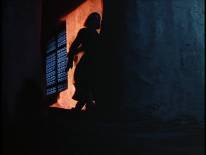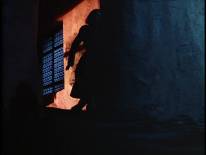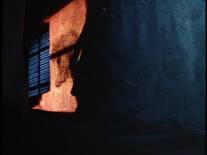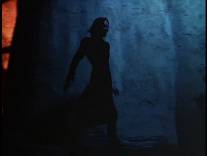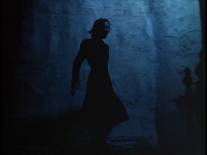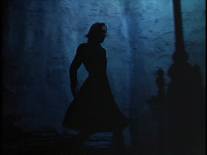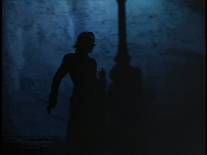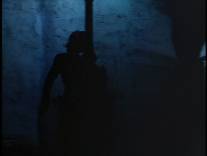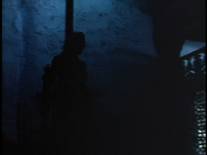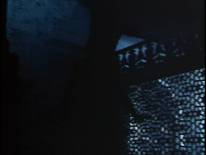Blue Nun/Red Desire:
The Palette of Piety, Passion, and Monstrosity in Black Narcissus
By Mary Bowen
Watching a Powell-Pressburger film is always an experience in intensity, not to be confused with an intense experience. The Archers create a distinct and sensory-laden world in their movies, a separate cinematic reality, where sights, sounds, and emotions are all heightened. An "intense experience" implies an outside force washing over the viewer, while an "experience in intensity" grants the viewer entrance into a realm outside him/herself. This is not a quarrel over semantics, but an alternative method of mapping a cinematic terra incognita. To judge the super-saturated colors, magical lighting, mythical storylines, and compelling score employed by the Archers as "too much" or "an assault to the senses" is to refuse learning a new language, or exploring a new country. Appealing to the senses alone does not create a world with a doorway, however. The image and sound must have meaning; the story feeds off of the sensory details, merging with myth past, present - and yes sometimes even the future - to finally emerge as its own vision. The 1947 Powell-Pressburger vision Black Narcissus is one such country - within its borders live many sights and sounds, many gradations of emotion, and consequently many stories.
Black Narcissus follows the lives of a small group of Anglo-catholic nuns, as they struggle to found a convent school in an abandoned palatial brothel resting high up in the Himalayas. The action centers on the reserved and repressed Sister Superior Clodagh (exquisitely realized by the very embodiment of English restraint, Deborah Kerr) and her constant battle against the sensual, pagan atmosphere of the mountainous Mopu. Her struggle between piety and passion is reflected in the vibrant clash of complementary colors infusing every aspect of the mise en scene, from the lighting to the set design. Cinematographer Jack Cardiff, in the documentary Painting with Light, said Van Gogh's use of complementary colors inspired his choice to contrast the greenish fill lights with red sunlight effects. He liked the "anger" in Van Gogh's palette, and truly the effect on screen is a deliciously ambiguous mix of violence and accord. Cool restraint (green/blue) is forever dueling with fiery passion (red/orange). At the same time, these arch-rivals naturally temper one another. An interesting example is the palace at Mopu where the sisters make their home. Built as a libidinal garden of delight (sexuality is associated throughout the film with red) the building's core houses the bluest room (See Fig.1.) The viewer is thus always aware they have entered a land of contradictions and choices, a place with the power to elicit strong and conflicting emotions.
 |
|
Fig. 1. The Clash of Complements. |
The central themes of repressed passion and the transformative powers of an isolated location reach their apex in the maniacal Sister Ruth (magnificently inhabited by Kathleen Byron). Ruth is Sister Clodagh's decadent doppelganger, gleefully letting her repressed passions consume her, and the film presents them as "sisters" throughout. Sporting porcelain complexions and classic bone structures, Byron and Kerr's physical similarities are exaggerated by their matching nun's habits. The nuns also share an attraction to Mopu's resident Englishman Mr. Dean (though Clodagh diligently suppresses it) and they are both distracted by romance-infused daydreams. Most significantly, they are the only two nuns the film ever shows with uncovered hair. Flashbacks to Clodagh's pre-convent days show a carefree girl in love, her loose hair blowing in the breeze. When Sister Ruth leaves the order, she dramatically exchanges her wimple for a stylish coiffure and vampish lipstick. Exposing her hair announces she is a sexual creature, a role Clodagh clearly relegates to the past. In the classic tradition of the doppelganger, only one of these "twins" will survive the encounter with one other. The latter half of the film concentrates on Ruth's deteriorating mental state and her lethal battle with Sister Clodagh for preeminence. The scenes leading up to Ruth's attempted murder of Sister Clodagh are some of the film's most visually and aurally riveting, and Ruth's journey from sickly outsider to murderous she-devil merit careful inspection.
Sister Ruth's vicious attack evokes Jacques Tourneur's artful 1943 film noir/horror Cat People. Like the strangely sympathetic villain of Cat People, Irena, Sister Ruth's passion for a man and her hatred for her romantic rival animalizes her. She assumes a feline's nocturnal wandering habits and silent method of stalking prey. The camera treats her like a cat, emphasizing her eyes in tight close-ups. The most notable of these is the ultra-close "panther shot" of Sister Ruth peering at Clodagh from the shadowy convent (see Fig. 2.). At that moment she intends to kill Clodagh and the absence of her body in the frame symbolizes her transformation into cat, and therefore killer.
 |
|
Fig.2. Sister Ruth: A Woman Scorned as Panther. |
|
While it is plausible to imagine the eclectic Archers drawing inspiration from a recent artistic B-picture, viewing Black Narcissus in terms of Cat People is useful because it demonstrates the former's exploration of repressed passion in women as an exploration of women as a caged, wild creatures.
Throughout the film, Sister Ruth is rendered feline. The first reference to her is made by the Mother Superior in the Convent of the Order of Mary's dining hall. Mother Superior briefly discusses in turn each of the sisters Clodagh will take to Mopu. As she does so, the camera shows each of the sisters at dinner. When Mother Superior tells Clodagh she should take Sister Ruth however, the camera cuts to an empty place at the table. Clodagh challenges the Mother Superior's decision, stating, "Sister Ruth is ill." Sister Ruth is first introduced to the audience through her absence, creating suspense and an aura of mystery about her. This device is not unlike the introduction of villains in horror films - which tend to deny the viewer visual access to the monster/killer early in the film - and it also suggests the femme fatale because it presents the female character as unknown. Indeed, the roles of villain and temptress fuse in Sister Ruth's animal-like characterization. Woman is other here and otherness implies the inhuman, both in its strictly animal and monstrous forms. The first information revealed about Ruth is that she is ill. Animals instinctively withdraw from sick or wounded members of their kind, illness being a sign of difference and threat, and from the beginning she is presented as someone cloistered from the others. Later at the Mopu palace, Ruth delights in skirting the precipitous edge of the terrace bell tower, aligning herself with cat-like agility and their love of high places. She even externalizes the trapped-cat mentality, manifesting the feline in her body language. In one scene, she longingly looks at the virile Mr. Dean from the window. Her hands hook through the window's cage-like screen, her "claws" bared. Later, when she visits his house, she steals through the jungle grass, panther-like. In her final attack of Clodagh, after her transformation to wild beast is complete, she mimics the fight methods of a cat: she creeps silently up to Clodagh at the bell tower, pounces on her, and when attempting to loosen Clodagh's grip from the bell-pull, she claws at the startled nun's hands. Essentially the two engage in that classical conflict of two women fighting for a man: "the catfight."
The Cat Woman theme persists in a short, but thematically-loaded, shot of Sister Ruth creeping through the shadowy palace to Sister Clodagh. The structure of the shot as a whole references Tourneur's visually poetic noir-thriller, while the unique lighting and composition evokes some of western culture's oldest dark myths. To do this remarkable sequence justice, it is necessary to examine Sister Ruth's progression in the shot frame by frame (see Fig. 3.).
|
|
|
Fig. 3. Sister Ruth's Journey Through the Shadows. |
At first glance, Sister Ruth's movements are merely a graceful study of light and shadow. As her form moves in and out of darkness, there are moments when she is obscured almost completely. When played at its normal speed, this creates an unreal quality, heightening the viewer's tension. Sister Ruth is all the more menacing because her physicality is obscured. Hidden in shadows, becoming a shadow herself, she is no longer merely an evil person about to harm the heroine Clodagh, but the idea of evil itself. Human psychology dictates that often what is unseen is the most suspenseful, because a person "fleshes-out" the perceived menace with their imagination.
Again, a comparison with Tourneur's Cat People proves useful. Tourneur applied the principal of the unseen menace to his entire film, and he employed the same shadow effect in Cat People's famous "swimming pool" scene in 1943 that Powell-Pressburger and Cardiff used in Black Narcissus in 1947. The correlation is all the more striking because the scenes are thematically identical: a woman, transformed in some fashion by lust and jealousy, stalks her perceived rival for a man's affections. Irena, the Cat Woman of the picture, encircles her victim Alice, who is all alone and vulnerable in a dimly-lit community swimming pool. Irena is supposedly a panther at this point, but all Alice and the viewers see are strange shadows traveling along the wall amidst the reflections of the water. At this stage in Black Narcissus Clodagh is unaware she is being stalked, unlike poor Alice in the pool; however the visual impact of both scenes is identical. There is the aforementioned disorientation effect, an uncertainty about what exactly is being shown, but also the way the camera travels with the shadowy figures creates a circular effect. Just as Irena circles Alice, the viewer gets the sense that Ruth is circling Clodagh. Ruth's progression in the shot is essentially linear, from left to right across the frame, but she is also moving slightly down. This downward progression, when viewed in motion, "spirals" creating the feeling Ruth is surrounding the unsuspecting Sister Clodagh.
The sequence of still frames in Fig. 3 lends itself to several other interpretations. The pinkish, orange light she steals past suggests the warmth and decadence of Hollywood romance, reminiscent of the sun setting over Scarlett O'Hara's Tara. Already given up to the darkness, Sister Ruth cuts a dark, cold figure against the warm light. The deep blue middle ground evokes the forties film noir world of dimly-lit streets and towering streetlamps. Ruth is at once the damsel in distress and the femme fatale. She embodies the schizophrenic and sexually-driven psyche of the prototypical noir character, and is therefore in visual harmony with this shadow world. The palace's architecture, revealed in the final frames once again hearkens back to the horror genre. The delicate lattice-work creates a pebbled dungeon-like façade in the half-light reminiscent of the 1930's Universal horror cycle, particularly James Whale's Frankenstein films. Sister Ruth's role in the story is that of the monster, a creature tied to both the natural and supernatural worlds bringing destruction in its wake. In her short journey through the dark convent, Sister Ruth traverses the realm of film genres. In doing so, she acts out her character's mental deterioration and the creative process of the Archers themselves: creating an altogether new reality by drawing on already established interpretations, or genres, of reality.
The character of Sister Ruth also anticipates the demonic horror cycle beginning in the late 1960's, and most fittingly, the settings she passes through in Fig. 3 parallel Dante's organization of Hell. At the left edge of the first four frames in Fig. 3 is a window-like structure. A window promises a glimpse of the sky, Paradiso, and emphasizes the downward motion of her trip. She is literally turning her back on Heaven when she attempts to murder Sister Clodagh. This image of a fall from grace anticipates Ruth's fall off the cliff at the end of the film, and equates her death with the demon's return to Hell. Once safely past the window, Ruth walks through a reddish pink light before immersing in dark blue shadows. Throughout the film the tension between red/pink and blue/green represents an ideological battle: passion and decadence vs. restraint and piety. Here the colors are not at odds however, merely depicting gradations of the same Hell. Dante's Inferno, at its very core, is ice cold. First Ruth must submerge herself in hellfire before she can reach the frozen blue bottom of Hell. In the latter half of the film, Ruth is consistently associated with fire imagery. She burns with a delirious fever, and when Mr. Dean rejects her advances (remember she has the hots for him) the world around her turns fiery red. This last bizarre incident of sensory overload, boldly depicted in the film frame by a massive saturation of red pigment, precedes the fainting spell from which she awakens "hell-bent" to destroy Clodagh.
At this point, the musical score by Brian Easedale warrants discussion, for all the visual elements in the climactic Clodagh-Ruth showdown were shot to correspond with an already-composed piece of music (Painting with Light). The result is a stunning fusion of sight and sound, with music providing the bridge between sight and feeling. Uncannily, the quasi-operatic nature of the score contributes to the feel of the later demonic horror genre. Combined with Kathleen Byron's gruesome appearance when she makes her "big entrance" onto the terrace, Black Narcissus leaps out of the conventions of forties cinema and into uncharted territory (See Fig. 4-6). The music crescendos when Sister Ruth suddenly appears in the doorway, her piercing gaze mirroring the piercing notes. Flash forward twenty-plus years to films like The Exorcist and The Omen Series, or even Jaws, and it quickly becomes apparent that the masterful melding of music and action in the horror genre would not have existed without the Archers.
 |
|
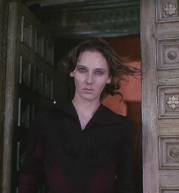 |
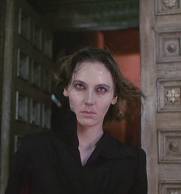 |
|
Fig. 4. Precursor to the Exorcist? |
|
Fig. 5-6. Sister Ruth: The Living Dead? |
Sister Ruth's connection with the dead and the demonic is reinforced by her stilting, zombie-like movements following her entrance (See Fig 5-6.) and the soundtrack consistently reinforces this view. Aside from the twisted Easdale composition, the only sound is Sister Clodagh's recitation of The Hail Mary as she rings the church bell (the task formerly relegated to Sister Ruth). The camera cuts between Ruth's eerie form creeping across the terrace and Sister Clodagh's exhausted and enraptured face as she prays and rings the bell. Clodagh spent the night full of foreboding but is for the moment oblivious to the danger that awaits, and pours all her concentration into her religious duty. This places Clodagh and Christianity in direct conflict with Ruth and her demonic affiliations. Sister Clodagh's recitation of The Hail Mary implies she receives divine protection, especially in light of her near-fall and ultimate victory over Ruth. Like a vampire foiled by a cross, Ruth falls off the mountain because Clodagh summoned the powers of Heaven to protect her. From beginning to end, Ruth and Clodagh's story is mythic; and mythology always demands great feelings, tremendous actions, and harrowing reversals of their inhabitants.
May it never be said that Powell and Pressburger's films are all style and no substance. Careful examination of Black Narcissus's bare elements - color, settings, music etc. - in a mere handful of scenes reveal myriad myths and philosophies. Every color is a feeling and every feeling a story. A nun may be an angel rising above the cruel earth or the fallen angel Satan himself. Van Gogh's pool halls live alongside popular culture - stories yet to be written are born alongside the old folktales and theologies. A compression of time through the visual and aural faculties - the artistic - is arguably what makes an Archer's film a world of its own. There is shape to Black Narcissus. It has scent and color. Reach out and touch it - the function of a flower is that of a door: it opens.
|
Works Cited
|
| Black Narcissus |
Dir. Michael Powell and Emeric Pressburger
Perf. Deborah Kerr, Kathleen Byron, and David Farrar
Rank/The Archers: 1947. ** |
| Cat People |
Dir. Jacques Tourneur
Perf. Simone Simon, Tom Conway, and Jane Randolph
RKO: 1943 |
| Painting with Light |
Dir. Craig McCall
Interviews w/ Jack Cardiff, Kathleen Byron, and Martin Scorsese
Criterion/Modus Operandi Films/Smoke and Mirror Films: 2000 |
|
**All images from Black Narcissus taken from the Criterion DVD edition: 2000. |
This paper was originally written in 2004 for my British Cinema I class, taught at Boston University by John Robert Kelly. Prof. Kelly, in my opinion, is a major force in fostering Archers awareness among American film students and without his inspiration and enthusiasm this paper would not exist.
Back to index





